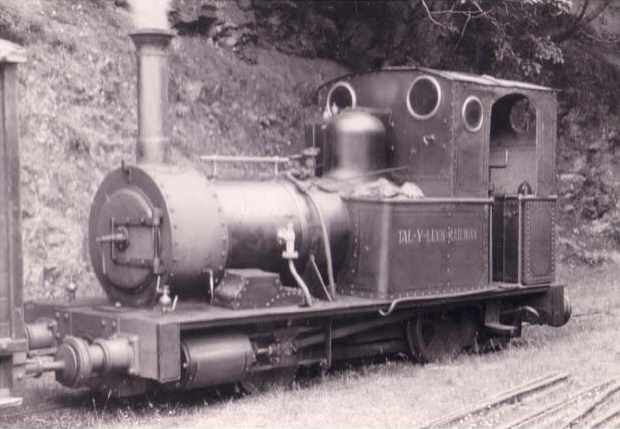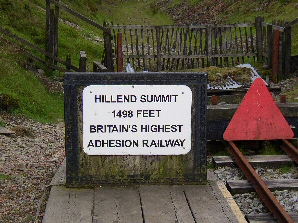|
Leadhills And Wanlockhead Railway
The Leadhills and Wanlockhead Railway is a narrow gauge railway in South Lanarkshire, Scotland. It is laid on the trackbed of the former Leadhills and Wanlockhead Branch of the Caledonian Railway which led off the main line between and Glasgow at Elvanfoot. Overview The preserved section runs from Leadhills for about towards Wanlockhead and is the highest adhesion railway in the UK. The rack and pinion Snowdon Mountain Railway is higher. Trains are currently diesel worked with the locomotive propelling the train up hill away from Leadhills. The original railway closed in the late 1930s shortly after the mines in Wanlockhead had closed. The railway currently stops at the border of South Lanarkshire and Dumfries and Galloway. Operation Trains operate on the push-pull principle as there are no run round loop facilities at the end of the run. Movements within the main station site at Leadhills are controlled from the reconstructed signal box which contains the original ... [...More Info...] [...Related Items...] OR: [Wikipedia] [Google] [Baidu] |
Scotland
Scotland (, ) is a country that is part of the United Kingdom. Covering the northern third of the island of Great Britain, mainland Scotland has a border with England to the southeast and is otherwise surrounded by the Atlantic Ocean to the north and west, the North Sea to the northeast and east, and the Irish Sea to the south. It also contains more than 790 islands, principally in the archipelagos of the Hebrides and the Northern Isles. Most of the population, including the capital Edinburgh, is concentrated in the Central Belt—the plain between the Scottish Highlands and the Southern Uplands—in the Scottish Lowlands. Scotland is divided into 32 administrative subdivisions or local authorities, known as council areas. Glasgow City is the largest council area in terms of population, with Highland being the largest in terms of area. Limited self-governing power, covering matters such as education, social services and roads and transportation, is devolved from the Scott ... [...More Info...] [...Related Items...] OR: [Wikipedia] [Google] [Baidu] |
Diesel Locomotive
A diesel locomotive is a type of railway locomotive in which the prime mover is a diesel engine. Several types of diesel locomotives have been developed, differing mainly in the means by which mechanical power is conveyed to the driving wheels. Early internal combustion locomotives and railcars used kerosene and gasoline as their fuel. Rudolf Diesel patented his first compression-ignition engine in 1898, and steady improvements to the design of diesel engines reduced their physical size and improved their power-to-weight ratios to a point where one could be mounted in a locomotive. Internal combustion engines only operate efficiently within a limited power band, and while low power gasoline engines could be coupled to mechanical transmissions, the more powerful diesel engines required the development of new forms of transmission. This is because clutches would need to be very large at these power levels and would not fit in a standard -wide locomotive frame, or wear too quic ... [...More Info...] [...Related Items...] OR: [Wikipedia] [Google] [Baidu] |
Transport In South Lanarkshire
Transport (in British English), or transportation (in American English), is the intentional Motion, movement of humans, animals, and cargo, goods from one location to another. Mode of transport, Modes of transport include aviation, air, land transport, land (rail transport, rail and road transport, road), ship transport, water, cable transport, cable, pipeline transport, pipeline, and space transport, space. The field can be divided into infrastructure, vehicles, and business operations, operations. Transport enables human trade, which is essential for the development of civilizations. Transport infrastructure consists of both fixed installations, including roads, railways, airway (aviation), airways, waterways, canals, and pipeline transport, pipelines, and terminals such as airports, train station, railway stations, bus stations, warehouses, trucking terminals, refueling depots (including fueling docks and fuel stations), and seaports. Terminals may be used both for intercha ... [...More Info...] [...Related Items...] OR: [Wikipedia] [Google] [Baidu] |
Heritage Railways In Scotland
This is a list of heritage, private and preserved railways throughout the United Kingdom, the Crown dependencies, and British Overseas Territories whether operational or closed, that are operated for charitable purposes or shareholder profit. Some also provide economic local transport. For rail museums, see ''List of British railway museums''. Many of the standard-gauge railways listed, including former branch lines and ex-mainline routes, were closed by British Railways under the Beeching Axe of the 1960s. Most have been restored and operate as heritage lines. A smaller number of lines were formerly industrial or colliery railways. Many of these preserved railways are mentioned in national and international tour guides, and visits may form part of a school curriculum or feature in other studies, including civil engineering, mechanics, social, economic and political history, visual arts and drama. This list also includes tramways. Nearly all tram services in Britain ende ... [...More Info...] [...Related Items...] OR: [Wikipedia] [Google] [Baidu] |
British Narrow Gauge Railways
There were more than a thousand British narrow-gauge railways ranging from large, historically significant common carriers to small, short-lived industrial railways. Many notable events in British railway history happened on narrow-gauge railways including the first use of steam locomotives, the first public railway and the first heritage railway, preserved railway. History Early railways: before 1865 The earliest narrow-gauge railways were crude wooden trackways used in coal mines to guide wooden Quarry tub, tubs. Because of the restricted loading gauge of the tunnels and the need for the tubs to be small enough to be pushed by one man, these railways were almost all narrow gauge. These underground lines often had short above-ground sections as well. After the start of the Industrial Revolution it became possible to create railways with iron tracks and wheels, which reduced the friction involved in moving wagons and made longer horse-hauled trains possible. These could mov ... [...More Info...] [...Related Items...] OR: [Wikipedia] [Google] [Baidu] |
Arrochar And Tarbet Railway Station
, symbol_location = gb , symbol = rail , image = Arrochar and Tarbet railway station, view along platform towards Glen Douglas and Glasgow.jpg , caption = View along platform towards Glen Douglas and Glasgow , borough = Arrochar & Tarbet, Argyll and Bute , country = Scotland , coordinates = , grid_name = Grid reference , grid_position = , manager = ScotRail , platforms = 2 , code = ART , original = West Highland Railway , pregroup = North British Railway , postgroup = LNER , years = 7 August 1894 , events = Opened , mpassengers = , footnotes = Passenger statistics from the Office of Rail and Road Arrochar and Tarbet railway station is a railway station on the West Highland Line in Scotland. It stands between the villages of Arrochar and Tarbet. It is sited from Craigendoran Junction, near Helensburgh, between Ardlui and Garelochhead. ScotRail manage the station and operate most services, others provided by Caledonian Sleeper. History Opened to p ... [...More Info...] [...Related Items...] OR: [Wikipedia] [Google] [Baidu] |
Wanlockhead Railway Station
Wanlockhead railway station was opened on 1 October 1902 as the terminus on the Leadhills and Wanlockhead Light Railway and served the lead mining area, farms and the village of Wanlockhead. Elvanfoot railway station in South Lanarkshire was the junction for the branch and was located on the west coast main line. It remained open until 2 January 1939 for passengers and freight. When Wanlockhead station opened in 1902, a year after Leadhills station, it became the highest standard gauge adhesion station in the United Kingdom at , from Elvanfoot. History Operated by the Caledonian Railway, it became part of the London, Midland and Scottish Railway during the Grouping of 1923. The line had been closed and lifted before the Scottish Region of British Railways came into existence upon nationalisation in 1948. The line suffered greatly from the closure of the lead mines and passenger traffic was slight, although the station was located near to the small village of Wanlockhead. T ... [...More Info...] [...Related Items...] OR: [Wikipedia] [Google] [Baidu] |
Dumfries And Galloway
Dumfries and Galloway ( sco, Dumfries an Gallowa; gd, Dùn Phrìs is Gall-Ghaidhealaibh) is one of 32 unitary council areas of Scotland and is located in the western Southern Uplands. It covers the counties of Scotland, historic counties of Dumfriesshire, Kirkcudbrightshire, and Wigtownshire, the latter two of which are collectively known as Galloway. The administrative centre and largest settlement is the town of Dumfries. The second largest town is Stranraer, on the North Channel (Great Britain and Ireland), North Channel coast, some to the west of Dumfries. Following the 1975 reorganisation of local government in Scotland, the three counties were joined to form a single regions and districts of Scotland, region of Dumfries and Galloway, with four districts within it. The districts were abolished in 1996, since when Dumfries and Galloway has been a unitary local authority. For lieutenancy areas of Scotland, lieutenancy purposes, the area is divided into three lieutenancy a ... [...More Info...] [...Related Items...] OR: [Wikipedia] [Google] [Baidu] |
Mining
Mining is the extraction of valuable minerals or other geological materials from the Earth, usually from an ore body, lode, vein, seam, reef, or placer deposit. The exploitation of these deposits for raw material is based on the economic viability of investing in the equipment, labor, and energy required to extract, refine and transport the materials found at the mine to manufacturers who can use the material. Ores recovered by mining include metals, coal, oil shale, gemstones, limestone, chalk, dimension stone, rock salt, potash, gravel, and clay. Mining is required to obtain most materials that cannot be grown through agricultural processes, or feasibly created artificially in a laboratory or factory. Mining in a wider sense includes extraction of any non-renewable resource such as petroleum, natural gas, or even water. Modern mining processes involve prospecting for ore bodies, analysis of the profit potential of a proposed mine, extraction of the desired materials, an ... [...More Info...] [...Related Items...] OR: [Wikipedia] [Google] [Baidu] |
Snowdon Mountain Railway
The Snowdon Mountain Railway (SMR; cy, Rheilffordd yr Wyddfa) is a narrow gauge rack and pinion mountain railway in Gwynedd, north-west Wales. It is a tourist railway that travels for from Llanberis to the summit of Snowdon, the highest peak in Wales. The SMR is the only public rack and pinion railway in the United Kingdom, and after more than 100 years of operation it remains a popular tourist attraction, carrying more than 140,000 passengers annually. The line is owned and operated by Heritage Great Britain, operators of several other tourist attractions in the United Kingdom. The railway is operated in some of the harshest weather conditions in Britain, with services curtailed from reaching the summit in bad weather and remaining closed during the winter from November to mid-March. Single carriage trains are pushed up the mountain by either steam locomotives or diesel locomotives. It has also previously used diesel railcars as multiple units. The traditional logo ... [...More Info...] [...Related Items...] OR: [Wikipedia] [Google] [Baidu] |
Leadhills
Leadhills, originally settled for the accommodation of miners, is a village in South Lanarkshire, Scotland, WSW of Elvanfoot. The population in 1901 was 835. It was originally known as Waterhead. It is the second highest village in Scotland, the highest being neighbouring Wanlockhead, south. It is near the source of Glengonnar Water, a tributary of the River Clyde. Local attractions Library The Leadhills Miners' Library (also known as the Allan Ramsay (poet), Allan Ramsay Library or the Leadhills Reading Society), founded in 1741 by 21 miners, the local schoolteacher and the local minister, specifically to purchase a collection of books for its members’ mutual improvement — its membership was not restricted to the miners; several non-miners, such as William Symington, John Brown (physician, born 1810), John Brown (author of ''Rab and his Friends'') and James Braid (surgeon), James Braid, were also full members — houses an extensive antiquarian book collection, local ... [...More Info...] [...Related Items...] OR: [Wikipedia] [Google] [Baidu] |






